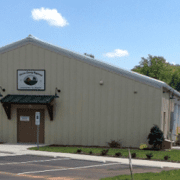Over the course of the next 12 months or so, the town of Stovall is going to be the site of some groundbreaking activity – literally.
A new senior center is going up at the corner of Oxford and Main streets, and local officials agree that the proposed location is perfectly placed to get a lot of use by folks who live in the northern part of the county.
The $3 million project has cleared all the initial pre-construction hurdles, and Granville County’s Senior Services Director Kathy May said work should begin this month, with an estimated completion date of August 2025.
May and Stovall Town Commissioner Jeffrey Stovall were guests on Tuesday’s TownTalk, and both agree that the new senior center will change the landscape of the tiny town located just a few miles north of Oxford on Highway 15.
The 4.5 acre-tract is situated across from the Stovall library and medical center and is nestled between Stovall Baptist Church and Town Hall.
And although the idea has been about seven years in the making, May said the timing is just right.
Did you know that Granville County has the largest percentage of people in the 50-59 age range? “I was shocked when I found that out fairly recently,” May said.
Forty percent of the county’s population is 50+, a demographic May and her staff know quite well. Residents over 50 are eligible to participate in senior center programs and events; services like transportation, congregate meals and meal delivery are for residents 60 years and older.
As residents “age in” to the services that the county’s senior center provides, May said it’s important to have a facility that can accommodate multiple activities at once.
The current senior center has been in service since the mid-1990’s, and while it’s a nice building (with original hardwood floors), May said it’s basically a single 1200-square-foot room, with no functional outdoor space other than a gravel parking lot.
The new center, by contrast, will have multiple spaces, a walking path and plenty of room outside that eventually will be home to a couple of pickle ball courts.
“A senior center is like a home away from home,” May explained. It’s a place where senior adults can reconnect with old friends and meet new ones, learn how to stay healthy and it keeps them from sitting at home being lonely, she said. The center staff can help connect them with vital community resources, another bonus.
They eat meals together, play games, attend workshops and take classes through the Creative Lifelong Learning program.
May said she plans to hold some of the CLL classes at the new center in Stovall.
“It’ll be great for seniors and the community as a whole,” Stovall said. “I really do think it’s going to bring the town together. He was elected to the town board of commissioners in the last election, and he said town leaders are working hard to make Stovall a place where young families want to live.
“We’re trending upward,” Stovall said, adding that the senior center creates a “confidence booster for us to continue to do the right thing.”
CLICK PLAY!







